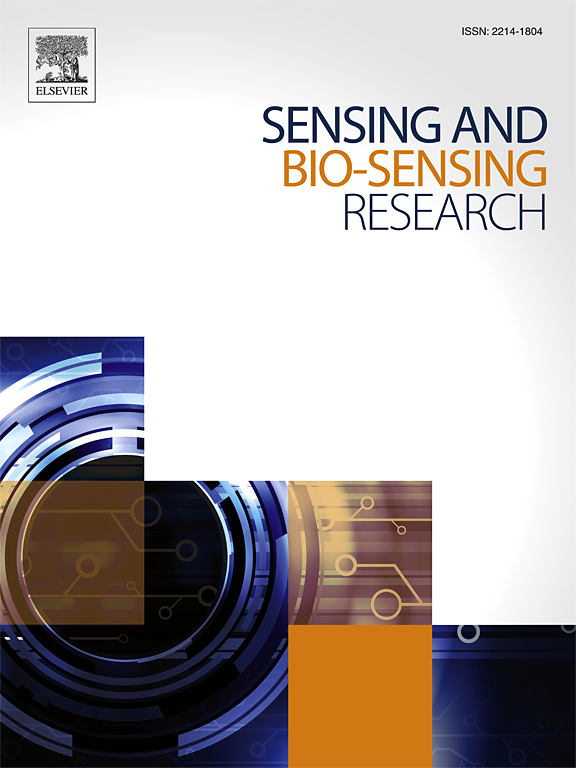A CRISPR/Cas12a electrochemical biosensing to detect pig mtDNA D-loop for ensuring food authenticity
IF 4.9
Q1 CHEMISTRY, ANALYTICAL
引用次数: 0
Abstract
Ensuring safe and accurately labeled food products is crucial for communities worldwide. One significant concern in food safety is the unintended inclusion of pork in products, which impacts food labeling, religious dietary practices, legal standards, and public health. Detecting such contamination is challenging due to complex food processing, requiring advanced methods for accurate identification. A CRISPR/Cas12a-based electrochemical biosensor has garnered attention for its rapidity, portability, high sensitivity, and specificity, leveraging trans-cleavage activity for precise detection. This study utilized a modified electrode, SPCE/Ceria/STV/Biotin-ssDNA-Methylene Blue (MB), characterized by SEM/EDX and voltammetry methods to examine morphology and electrochemical behavior. Optimization using the Box-Behnken Design (BBD) yielded ideal conditions: 30 min STV incubation, 1.5 μM probe concentration, 240 min probe incubation, 0.1 % BSA concentration, 30 min target incubation, and 2 μL target volume. These parameters enabled the development of an ultrasensitive biosensor with detection and quantification limits of 4 fM and 71 fM, respectively. Operating within a range of 10 nM to 100 fM, the biosensor achieved 1.1 % RSD. This CRISPR-based biosensor successfully detected pig mtDNA in raw and processed meat samples, achieving a 100.82 % recovery rate for corned samples and maintaining stability for 14 days. These findings highlight the biosensor's potential as a rapid, stable, ultrasensitive, and ultraspecific alternative for food monitoring. Its robustness makes it particularly suitable for ensuring the authenticity of animal-derived food products susceptible to counterfeiting.
利用CRISPR/Cas12a电化学生物传感技术检测猪mtDNA d环,确保食品的真实性
确保食品安全和标签准确对世界各地的社区至关重要。食品安全的一个重大问题是无意中在产品中加入猪肉,这会影响食品标签、宗教饮食习惯、法律标准和公共卫生。由于复杂的食品加工过程,检测这种污染是具有挑战性的,需要先进的方法来准确识别。基于CRISPR/ cas12的电化学生物传感器因其快速、便携、高灵敏度和特异性,利用反式裂解活性进行精确检测而受到关注。本研究采用改性电极SPCE/Ceria/STV/ biotin - ssdna -亚甲基蓝(MB),通过SEM/EDX和伏安法对其形貌和电化学行为进行了表征。采用Box-Behnken设计(BBD)优化得到理想条件:STV孵育30 min,探针浓度为1.5 μM,探针孵育240 min, BSA浓度为0.1%,目标孵育30 min,目标体积为2 μL。这些参数使超灵敏生物传感器的发展,检测和定量限分别为4 fM和71 fM。在10 nM至100 fM范围内工作,生物传感器的RSD达到1.1%。这种基于crispr的生物传感器成功地检测了生肉和加工肉品中的猪mtDNA,对玉米样品的回收率达到100.82%,并保持了14天的稳定性。这些发现突出了生物传感器作为一种快速、稳定、超灵敏和超特异的食品监测替代方案的潜力。它的坚固性使其特别适合于确保易受假冒的动物源性食品的真实性。
本文章由计算机程序翻译,如有差异,请以英文原文为准。
求助全文
约1分钟内获得全文
求助全文
来源期刊

Sensing and Bio-Sensing Research
Engineering-Electrical and Electronic Engineering
CiteScore
10.70
自引率
3.80%
发文量
68
审稿时长
87 days
期刊介绍:
Sensing and Bio-Sensing Research is an open access journal dedicated to the research, design, development, and application of bio-sensing and sensing technologies. The editors will accept research papers, reviews, field trials, and validation studies that are of significant relevance. These submissions should describe new concepts, enhance understanding of the field, or offer insights into the practical application, manufacturing, and commercialization of bio-sensing and sensing technologies.
The journal covers a wide range of topics, including sensing principles and mechanisms, new materials development for transducers and recognition components, fabrication technology, and various types of sensors such as optical, electrochemical, mass-sensitive, gas, biosensors, and more. It also includes environmental, process control, and biomedical applications, signal processing, chemometrics, optoelectronic, mechanical, thermal, and magnetic sensors, as well as interface electronics. Additionally, it covers sensor systems and applications, µTAS (Micro Total Analysis Systems), development of solid-state devices for transducing physical signals, and analytical devices incorporating biological materials.
 求助内容:
求助内容: 应助结果提醒方式:
应助结果提醒方式:


